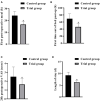Analysis of the Rehabilitation Efficacy and Nutritional Status of Patients After Endoscopic Radical Thyroidectomy by Fast Track Surgery Based on Nutritional Support
- PMID: 35586505
- PMCID: PMC9108205
- DOI: 10.3389/fsurg.2022.897616
Analysis of the Rehabilitation Efficacy and Nutritional Status of Patients After Endoscopic Radical Thyroidectomy by Fast Track Surgery Based on Nutritional Support
Abstract
Objective: To investigate and analyze the effect of fast track surgery (FTS) based on nutritional support on the improvement of rehabilitation efficacy and nutritional status of patients after radical lumpectomy for thyroid cancer.
Methods: Eighty-six patients admitted to our hospital for radical lumpectomy for thyroid cancer between April 2018 and April 2021 were selected, of which 40 patients admitted between April 2018 and April 2019 were included in the control group with conventional perioperative care. Forty-six patients admitted between May 2019 and April 2021 were included in the trial group with FTS care based on nutritional support. The two groups of patients were compared in terms of postoperative feeding time, length of stay, time out of bed, VAS scores, albumin (ALB), total protein (TP) and prealbumin (PA) levels, negative emotions [Mental Health Test Questionnaire (DCL-90)], quality of life [General Quality of Life Inventory (GQOLI-74)] and complication rates.
Results: The patients in the trial group had shorter feeding time, hospitalization time and time out of bed than the control group (P < 0.05). After the intervention, ALB, TP and PA levels were higher in the trial group than in the control group vs. preoperatively (P < 0.05); VAS scores in the trial group were lower than VAS scores in the control group during the same period (P < 0.05). The postoperative DCL-90 scores of the trial group were lower than those of the control group (P < 0.05); the GQOLI-74 scores and total scores of the trial group were higher than those of the control group at the 3-month postoperative follow-up (P < 0.05). The overall incidence of complications such as hoarseness, choking on water, hand and foot numbness, wound infection, and hypocalemia was lower in the trial group than in the control group (P < 0.05).
Conclusion: The implementation of FTS care based on nutritional support for patients after endoscopic radical thyroidectomyr can effectively improve the postoperative recovery and reduce their pain level, as well as help improve their nutritional status, negative emotions and improve their quality of life, which is worth promoting.
Keywords: fast track surgery; lumpectomy; nutritional status; nutritional support; radical thyroidectomy; rehabilitation outcome.
Copyright © 2022 Qu, Bu, Yang, Liu and Xie.
Conflict of interest statement
The authors declare that the research was conducted in the absence of any commercial or financial relationships that could be construed as a potential conflict of interest.
Figures




Similar articles
-
Effect of Fast-Track Surgery Based on Nutritional Support in the Rehabilitation of Patients Undergoing Radical Thyroidectomy and Lateral Lymphadenectomy: A Retrospective Analysis.Ann Ital Chir. 2025;96(1):29-39. doi: 10.62713/aic.3764. Ann Ital Chir. 2025. PMID: 39815837
-
The effect of accelerated rehabilitation nursing on postoperative recovery, nutritional status, and psychological status in patients with gastric cancer.Am J Transl Res. 2021 Apr 15;13(4):3666-3673. eCollection 2021. Am J Transl Res. 2021. PMID: 34017549 Free PMC article.
-
Impact of fast-track surgery-oriented care pathways on perioperative rehabilitation indices in patients undergoing radical prostatectomy for prostate cancer.Am J Transl Res. 2024 May 15;16(5):1620-1629. doi: 10.62347/ZMUX1738. eCollection 2024. Am J Transl Res. 2024. PMID: 38883357 Free PMC article.
-
A comparative study on the efficacy of fast-track surgery in the treatment of esophageal cancer patients combined with metabolic syndrome.Oncol Lett. 2017 Oct;14(4):4812-4816. doi: 10.3892/ol.2017.6759. Epub 2017 Aug 17. Oncol Lett. 2017. PMID: 29085484 Free PMC article.
-
Fast-track cardiac care for adult cardiac surgical patients.Cochrane Database Syst Rev. 2016 Sep 12;9(9):CD003587. doi: 10.1002/14651858.CD003587.pub3. Cochrane Database Syst Rev. 2016. PMID: 27616189 Free PMC article. Review.
Cited by
-
Advances in the assessment of cosmetic outcomes, sensory alteration in surgical areas, and health-related quality of life of endoscopic thyroidectomy.World J Surg Oncol. 2024 Feb 13;22(1):52. doi: 10.1186/s12957-024-03307-7. World J Surg Oncol. 2024. PMID: 38347606 Free PMC article. Review.
-
Patient-reported oral function and psychological well-being outcomes of papillary thyroid cancer patients (PTC) after surgery: a cross-sectional study.Surg Endosc. 2024 Feb;38(2):813-820. doi: 10.1007/s00464-023-10603-y. Epub 2023 Dec 7. Surg Endosc. 2024. PMID: 38062180
References
LinkOut - more resources
Full Text Sources
Research Materials
Miscellaneous

